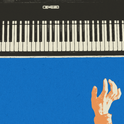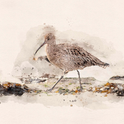This Easter just gone, like every Easter, was a time for Passion: Passiontide, and the reenactment of the well-trod path to Calvary, through the musical stations of Johann Sebastian Bach. The composer told the same story in at least two very different ways—there are other versions that haven’t survived the centuries—with his St John Passion and St Matthew Passion.
Bach stands at the head of what we understand by classical music. He is the supreme master of music as abstract design, keyboard music of the most intellectual ingenuity and visceral impact. At the same time, Bach’s vocal music can probe the deepest wounds of human existence and express the fiercest joys. The elision of the pain of the Passion with the almost erotic quality of the music’s engagement with it give Bach’s Passions their extraordinary intensity, nowhere more than in the two searing arias from the John and the Matthew for soprano, flute and oboe, “Zerfliesse” and “Aus Liebe”. They throb with a sweet, harmonic pain that generates not only a musical but also a physical sensation.
It’s a commonplace that Bach’s music involves a fusion of German spirituality and Italian operatic gesture, and, after a month of Lenten spiritual Passion, the aftermath of Easter has given me an Italian tour of a very different, but nevertheless related, musical torment: what the Italians might call Tormento d’Amore.
♦♦♦
In the Autumn of 2020, in the lull between pandemic restrictions, I managed to make it to Naples for a recording of Italian operatic arias written in the 17th and 18th centuries. It was heaven to be in the sublime disorder of southern Italy, singing in an apartment decorated with extravagant baroque ceiling paintings in a graffiti-scrawled building with gigantic Neapolitan doors, cheek by jowl with market stalls selling fish, fruit, vegetables and meat—abundant still lives to rival their 17th-century painted competitors.
The point of the disc was to show how the operatic aria started out in mid-17th-century Venice, before migrating to Naples, which then returned the compliment by influencing the Venetian original. It sounds very intellectual, but it’s music of raw power—Tormento d’Amore is, in fact, what we called the disc—and the programme ends with an astonishing Vivaldi aria from his opera Farnace, reminiscent of “Winter” from his Four Seasons. “Gelido in ogni vena”—“Frozen in every vein”—embodies the icy, jagged horror of a father who has ordered the death of his innocent son.
So here I was, touring Italy with Italian musicians—the Capella Neapolitana under their founder, Antonio Florio—and, essentially, mimicking that aria-journey from Venice to Naples. First stop: Pordenone, a quiet town three-quarters of an hour from Venice, home of the eponymous artist Il Pordenone, whose Madonna della Misericordia hangs in the Duomo. Then Trieste, Jan Morris’s “Capital of Nowhere”, which deserves more space than I can possibly give it here, except to say that the opera house where we performed, the Teatro Verdi, was run in the 1970s by a man called the Baron Raffaele Douglas de Banfield-Tripcovich. That already tells you at least something about Trieste.
We ended up back in Naples, at the tiny Teatro Sannazaro. There’s something very special about singing to an audience in their own language; you sense—indeed, see—an immediate response as you shape the text, and the feedback loop is inspirational. This was an extreme case of delivering coals to Newcastle, however, as our last encore was a late 19th-century popular song from the era of “Funiculì, funiculà” and “O sole mio”: a nasty little tale of murderous jealousy, in Neapolitan dialect, entitled, “Lu cardillo”. Man sends goldfinch to spy on girlfriend; if she’s asleep, he tells the bird, wake her up; if she’s on her balcony, don't get intoxicated from savouring her delicious odour; if she’s with another man, stab her to the heart and bring back the blood in your beak. Nice.
I’d learnt how to pronounce the dialect in a Neapolitan kitchen back when we first recorded the album, and it seemed at least passable, though I did offer it with a Neapolitan hand gesture of apology. It’s not entirely possible for a classical singer to achieve the detached Neapolitan sang froid of the classic version by the great Roberto Murolo, king of Neapolitan song who recorded his Antologia cronologica della canzone partenopea, a 12-LP collection of the songs of Naples from the 1100s to the 1900s, in the 1960s, accompanying himself on the guitar. At the same time, there’s not always such a great distance between Neapolitan popular song and the world of opera—the music of “Te voglio bene assaje” (“I love you so much”) has often been linked to the composer Gaetano Donizetti.
♦♦♦
After the concert, I had a restorative hot chocolate and toasted sandwich in a fabled Neapolitan café not far from the theatre. It wasn’t till I got home that I listened to a recent Radio 3 documentary and learnt that it was in the Gran Caffé Gambrinus in 1892 that one of the John the Baptist of Italian fascism, Gabriele d’Annunzio, was challenged by a friend to write a poem in Neapolitan dialect, and scribbled the words of “A vucchella” in pencil on a marble table. Twelve years later, Tosti turned it into one of the most beloved of Neapolitan songs.
Sì comm’a ’nu sciurillo,
Tu tiene ’na vucchella,
’Nu poco pucurillo,
Appassuliatella.
Yes, just like a little flower,
You’ve got a sweet mouth,
Just a little bit
withered.













